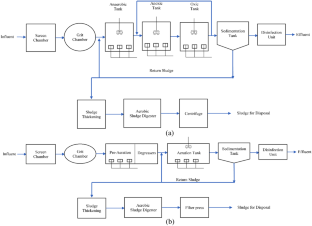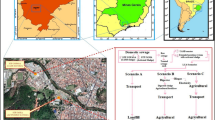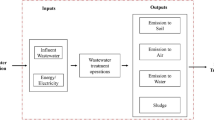Abstract
Life cycle assessment (LCA) is a tool for the analysis of all environmental impacts associated with a product or system. The objective of our study was to evaluate and compare the environmental impacts of Anaerobic-Anoxic-Oxic (A2O) and Extended Aeration Activated Sludge (EAAS) systems of the activated sludge treatment plant for urban wastewater treatments (in Tehran) using the LCA method, as well as to compare the differences of Simapro and Gabi software results. The LCA was carried out using Simapro 9.3.0.2 software, including CML-IA baseline, BEES+, and IMPACT 2002 + assessment methods. Also, the results obtained from the CML method of SimaPro software were compared and validated with the results obtained from the GaBi 9.21.68 software. The results indicated that using the SimaPro software, including CML, and BEES + methods, the Ekbatan Wastewater Treatment (A2O system) has the 6% and 16% higher environmental impacts in the acidification and global warming impact categories, respectively, and the Mahalati Wastewater Treatment (EAAS system) has 31% higher environmental impact in the eutrophication impact category. In damage categories, the Ekbatan Wastewater Treatment (A2O system) has 14%, 15%, and 6% higher environmental impacts in the resources, climate change, and human health damage categories, respectively, compared to the Ekbatan Wastewater Treatment. In the ecosystem quality damage category, the Mahalati Wastewater Treatment (EAAS system) has a 4% higher environmental impact than Ekbatan Wastewater Treatment (A2O system). Comparing the results between SimaPro and GaBi software demonstrated that the results are very similar to each other, and the results of the LCA are not dependent on the software used in this study. To enhance wastewater treatment in Iran, utilizing new technologies for energy efficiency, transitioning to renewable energy sources, promoting community acceptance of treated wastewater for various uses, and implementing stringent control measures are crucial steps.










Similar content being viewed by others
Data availability
The data are available whenever the journal require.
References
Abyar, H., Younesi, H., & Nowrouzi, M. (2020). Life cycle assessment of A2O bioreactor for meat processing wastewater treatment: An endeavor toward the achievement of environmental sustainable development. Journal of Cleaner Production, 257, 120575. https://doi.org/10.1016/j.jclepro.2020.120575.
Asadollahfardi, G., Panahandeh, A., Moghadam, E. I., Masoumi, S., & Tayebi Jebeli, M. (2022). Environmental life cycle assessment of different types of the municipal wastewater pipeline network. Environmental Quality Management, (September 2021), 1–14. https://doi.org/10.1002/tqem.21864.
AWWA (2022). Standard method for examination of water and wastewater, 24 edition,ISBN:9780875532998,USA.
Bahi, Y., Akhssas, A., Bahi, A., Elhachmi, D., & Khamar, M. (2020). Environmental assessment of a wastewater treatment plant using life cycle assessment (LCA) approach: Case of Ain Taoujdate Morocco. International Journal of Advanced Research in Engineering and Technology, 11(5), 353–362. https://doi.org/10.34218/IJARET.11.5.2020.036.
Banti, D. C., Tsangas, M., Samaras, P., & Zorpas, A. (2020). LCA of a membrane bioreactor compared to activated sludge system for municipal wastewater treatment. Membranes, 10(12), 1–15. https://doi.org/10.3390/membranes10120421.
Bao, Z., Sun, S., & Sun, D. (2015). Characteristics of direct CO2 emissions in four full-scale wastewater treatment plants. Desalination and Water Treatment, 54(4–5), 1070–1079. https://doi.org/10.1080/19443994.2014.940389.
Bhatt, A., Sahu, N., Dada, A. C., Prajapati, S. K., & Arora, P. (2024). Assessing sustainability of Microalgae-based Wastewater Treatment: Environmental considerations and impacts on Human Health. Journal of Environmental Management, 354, 120435. https://doi.org/10.1016/j.jenvman.2024.120435.
Blanco, D., Collado, S., Laca, A., & Díaz, M. (2016). Life cycle assessment of introducing an anaerobic digester in a municipal wastewater treatment plant in Spain. Water Science and Technology, 73(4), 835–842. https://doi.org/10.2166/wst.2015.545.
Das, S., Singh, C. K., Sodhi, K. K., & Singh, V. K. (2023). Circular Economy Approaches for Water Reuse and Emerging Contaminant Mitigation: Innovations in Water Treatment. Environment, Development and.
EPA. (2010). Greenhouse Gas Emissions Estimation Methodologies for Biogenic Emissions from selected source categories: Solid Waste Disposal Wastewater Treatment Ethanol Fermentation. US Environmental Protection Agency, 0210426, 1–43. https://www3.epa.gov/ttnchie1/efpac/ghg/GHG_Biogenic_Report_draft_Dec1410.pdf.
Eriksson, A. (2012). Identification of environmental impacts for the vectus PRT system using LCA. M.Sc. Thesis. Department of Energy and Technology. Uppsala University. Swedish.
Eskandari Ashgofti, A., Morovati, M., Alaiee, E., & Alavi, K. (2020). Investigating the wastewater treatment system of the Tehran Oil Industry Research Institute using the Life Cycle Assessment Method. The Journal of Tolooebehdasht, 19(2), 96–108. https://doi.org/10.18502/tbj.v19i2.3399.
Fragaszy, S. R., Jedd, T., Wall, N., Knutson, C., Fraj, M. B., Bergaoui, K., Svoboda, M., Hayes, M., & McDonnell, R. (2020). Drought Monitoring and Warning System for the Middle East and North Africa, B. Am. Meteorol. Soc., 101, 904–910, https://doi.org/10.1175/BAMS-D-18-0084.1, 2020.
Gomez, S. S. R., Castillo, N. A. H., Orozo, I. H., Galarza, A. A., Larragoitia, S. A. C., Flores, M. M. A., & Vazques, V. A. (2023). Life cycle assessment of a wastewater treatment plant in an urban area using the environmental footprint method. Environment Development and Sustainability. https://doi.org/10.1007/s10668-023-04273-y.
Guo, J., Zhang, W., Zhang, J., Xie, L., Zeng, X., Zhong, J., Zhao, O., Yang, K., Li, Z., Zou, R., Bai, Z., Zou, R., Bai, Z., Wang, Q., & Zhang, C. (2024). Carbon Reduction measures-based Life Cycle Assessment of the photovoltaic-supported sewage treatment system. Sustainable Cities and Society, 101, 105074. https://doi.org/10.1016/j.scs.2023.105074.
Hendi, G. N. B., Rahmanzadeh, M., Hoveidi, H., & Mehrdadi, N. (2021). The Life-Cycle Assessment of Urban Sewage Sludge Disposal Systems of Ekbatan Tehran Wastewater Treatment Plant. Environmental Energy and Economic Research, 5(1), 1–18. https://doi.org/10.22097/eeer.2020.237899.1162.
Hwang, K. L., Bang, C. H., & Zoh, K. D. (2016). Characteristics of methane and nitrous oxide emissions from the wastewater treatment plant. Bioresource Technology, 214, 881–884. https://doi.org/10.1016/j.biortech.2016.05.047.
ISO 14040. (2006). Environmental management-life cycle assessment principles and framework (ISO 140402006). International Organization for Standardization.
ISO 14044. (2006). Environmental management-life cycle assessment requirements and guidelines (ISO 14044:2006). International Organization for Standardization.
Limphitakphong, N., Pharino, C., & Kanchanapiya, P. (2016). Environmental impact assessment of centralized municipal wastewater management in Thailand. International Journal of Life Cycle Assessment, 21(12), 1789–1798. https://doi.org/10.1007/s11367-016-1130-9.
Liu, J., Sun, B., Piao, W., & Jin, M. (2024). Evaluation of the Environmental Impact and Energy Utilization Efficiency of Wastewater Treatment Plants in Tumen River Basin Based on a Life Cycle Assessment + Data Envelope Analysis Model. Sustainability, 16(4), 1690. https://doi.org/10.3390/su16041690.
Lopes, T. A. S., Queiroz, L. M., Torres, E. A., & Kiperstok, A. (2020). Low complexity wastewater treatment process in developing countries: A LCA approach to evaluate environmental gains. Science of the Total Environment, 720. https://doi.org/10.1016/j.scitotenv.2020.137593.
Mannina, G., Rebouças, T. F., Cosenza, A., & Chandran, K. (2019). A plant-wide wastewater treatment plant model for carbon and energy footprint: Model application and scenario analysis. Journal of Cleaner Production, 217, 244–256. https://doi.org/10.1016/j.jclepro.2019.01.255.
Metcalf, W., & Eddy, C. (2014). Wastewater engineering: treatment and resource recovery. In: Wastewater Engineering: Treatment and Resource Recovery, fifth ed.
Mohammadi, M., & Fataei, E. (2019). Comparative life cycle assessment of municipal wastewater treatment systems: Lagoon and activated sludge. Caspian Journal of Environmental Sciences, 17(4), 327–336. https://doi.org/10.22124/cjes.2019.3806.
Nakatsuka, N., Kishita, Y., Kurafuchi, T., & Akamatsu, F. (2020). Integrating wastewater treatment and incineration plants for energy- ef fi cient urban biomass utilization: A life cycle analysis. Journal of Cleaner Production, 243, 118448. https://doi.org/10.1016/j.jclepro.2019.118448.
Nguyen, T. K. L., Ngo, H. H., Guo, W., Chang, S. W., Nguyen, D. D., Nghiem, L. D., Liu, Y., Ni, B., & Hai, F. I. (2019). Insight into greenhouse gases emissions from the two popular treatment technologies in municipal wastewater treatment processes. Science of the Total Environment, 671, 1302–1313. https://doi.org/10.1016/j.scitotenv.2019.03.386.
Nguyen, T. K. L., Ngo, H. H., Guo, W., Chang, S. W., Nguyen, D. D., Nguyen, T. V., & Nghiem, D. L. (2020). Contribution of the construction phase to environmental impacts of the wastewater treatment plant. Science of the Total Environment, 743, 140658. https://doi.org/10.1016/j.scitotenv.2020.140658.
Nguyen, T. K. L., Ngo, H. H., Guo, W., Nghiem, L. D., Qian, G., Liu, Q., Liu, J., Chen, Z., Bui, X. T., & Mainali, B. (2021). Assessing the environmental impacts and greenhouse gas emissions from the common municipal wastewater treatment systems. Science of the Total Environment, 801, 149676. https://doi.org/10.1016/j.scitotenv.2021.149676.
Patel, K., & Singh, S. K. (2022). A life cycle approach to environmental assessment of wastewater and sludge treatment processes. Water and Environment Journal, 1–13. https://doi.org/10.1111/wej.12774.
Postacchini, L., Lamichhane, K. M., Furukawa, D., Babcock, R. W., Ciarapica, F. E., & Cooney, M. J. (2016). Life cycle assessment comparison of activated sludge, trickling filter, and high-rate anaerobic-aerobic digestion (HRAAD). Water Science and Technology, 73(10), 2353–2360. https://doi.org/10.2166/wst.2016.087.
Preisner, M., Neverova-Dziopak, E., & Kowalewski, Z. (2020). Analysis of Eutrophication potential of municipal Wastewater. Water Science and Technology, 81(91), 1994–2003. https://doi.org/10.2166/wst.2020.254.
Ren, Y., Wang, J., Xu, L., Liu, C., Zong, R., Yu, J., & Liang, S. (2015). Direct emissions of N2O, CO2, and CH4 from A/A/O bioreactor systems: Impact of influent C/N ratio. Environmental Science and Pollution Research, 22(11), 8163–8173. https://doi.org/10.1007/s11356-015-4408-8.
Resende, J. D., Nolasco, M. A., & Pacca, S. A. (2019). Life cycle assessment and costing of wastewater treatment systems coupled to constructed wetlands. Resources Conservation and Recycling, 148(May), 170–177. https://doi.org/10.1016/j.resconrec.2019.04.034.
Roghani, B., Tabesh, M., Amrollahi, M. S., & Venkatesh, G. (2017). Estimation and Evaluation of Greenhouse Gas Emissions during the life-cycle of Wastewater pipelines: Case Study of Tehran, Iran. Civil Engineering Infrastructures Journal (Ceij) (Journal of Faculty of Engineering), 50(1), 191–206. https://doi.org/10.7508/ceij.2017.01.012.
Tabesh, M., Feizee Masooleh, M., Roghani, B., & Motevallian, S. S. (2019). Life-Cycle Assessment (LCA) of Wastewater treatment plants: A case study of Tehran, Iran. International Journal of Civil Engineering, 17(7), 1155–1169. https://doi.org/10.1007/s40999-018-0375-z.
Torre, A., Vazquez-Rowe, I., Parodi, E., & Kahhatt, R. (2024). A Multi-criteria decision Framework for Circular Wastewater Systems in emerging megacities of the Global South. Science of the Total Environment, 912, 169085–169085. https://doi.org/10.1016/j.scitotenv.2023.169085.
Yan, X., Li, L., & Liu, J. (2014). Characteristics of greenhouse gas emission in three full-scale wastewater treatment processes. Journal of Environmental Sciences (China), 26(2), 256–263. https://doi.org/10.1016/S1001-0742(13)60429-5.
Yapıcıoğlu, P. (2021). Minimization of greenhouse gas emissions from extended aeration activated sludge process. Water Practice and Technology, 16(1), 96–107. https://doi.org/10.2166/wpt.2020.100.
Zheng, X., & Lam, K. L. (2024). An overview of Environmental Co-benefits and Trade-offs to Reduce Greenhouse Gas Emissions in Municipal Wastewater Management. Sustainable Production and Consumption. https://doi.org/10.1016/j.spc.2024.02.002. ,46,1–10.
Funding
The authors declare that no funds, grants, or other support were received during the preparation of this manuscript.
Author information
Authors and Affiliations
Corresponding author
Ethics declarations
Ethical approval
This is not applicable for my study.
Consent to participate
All authors give informed consent to participate in the study.
Consent to Publish
All authors agreed with the content, and all gave explicit consent to publish their data on the paper submitted in the journal of Environment, Development and Sustainability.
Competing interests
We, the author’s team, certify that we have no affiliations with or involvement in any organization or entity with any financial interest (honoraria; educational grants; participation in speakers’ bureaus; membership, employment, consultancies, stock ownership, or other equity interest; and expert testimony or patent-licensing arrangements), or non-financial interest (such as personal or professional relationships, affiliations, knowledge or beliefs) in the subject matter or materials discussed in this manuscript.
Additional information
Publisher’s Note
Springer Nature remains neutral with regard to jurisdictional claims in published maps and institutional affiliations.
Rights and permissions
Springer Nature or its licensor (e.g. a society or other partner) holds exclusive rights to this article under a publishing agreement with the author(s) or other rightsholder(s); author self-archiving of the accepted manuscript version of this article is solely governed by the terms of such publishing agreement and applicable law.
About this article
Cite this article
Movassagh Inchehboroun, B., Asadollahfardi, G. & Delnavaz, M. Life cycle assessment of anaerobic-anoxic-oxic and extended aeration of the activated sludge treatment system for urban wastewater treatment: a case study in Iran. Environ Dev Sustain (2024). https://doi.org/10.1007/s10668-024-04846-5
Received:
Accepted:
Published:
DOI: https://doi.org/10.1007/s10668-024-04846-5




